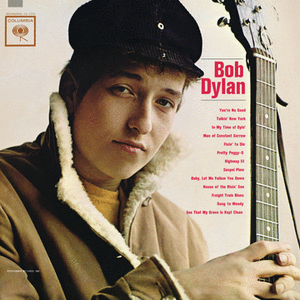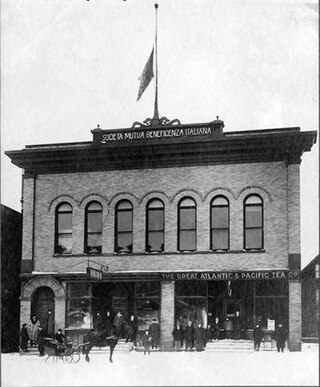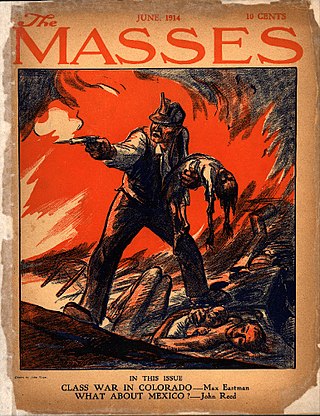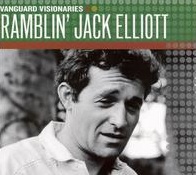
Woodrow Wilson Guthrie was an American singer-songwriter and composer who was one of the most significant figures in American folk music. His work focused on themes of American socialism and anti-fascism and inspired several generations both politically and musically with songs such as "This Land Is Your Land".

Calumet is a village in the Upper Peninsula of the U.S. state of Michigan. The village is located within Calumet Township, Houghton County, and had a population of 621 at the 2020 census.

Bob Dylan is the debut studio album by the American singer-songwriter Bob Dylan, released on March 19, 1962, by Columbia Records. The album was produced by Columbia talent scout John H. Hammond, who had earlier signed Dylan to the label, a controversial decision at the time. The album primarily features folk standards but also includes two original compositions, "Talkin' New York" and "Song to Woody". The latter was an ode to Woody Guthrie, a significant influence in Dylan's early career.

"This Land Is Your Land" is a song by American folk singer Woody Guthrie. One of the United States' most famous folk songs, its lyrics were written in 1940 in critical response to Irving Berlin's "God Bless America". Its melody is based on a Carter Family tune called "When the World's on Fire". When Guthrie was tired of hearing Kate Smith sing "God Bless America" on the radio in the late 1930s, he sarcastically called his song "God Blessed America for Me" before renaming it "This Land Is Your Land".

The Italian Hall disaster was a tragedy that occurred on Wednesday, December 24, 1913, in Calumet, Michigan, United States. Seventy-three people – mostly striking mine workers and their families – were crushed to death in a stampede when someone falsely shouted "fire" at a crowded Christmas party.

Gilbert Vandine "Cisco" Houston was an American folk singer and songwriter, who is closely associated with Woody Guthrie due to their extensive history of traveling and recording together.
John Cohen was an American musician, photographer and film maker who performed and documented the traditional music of the rural South and played a major role in the American folk music revival. In the 1950s and 60s, Cohen was a founding member of the New Lost City Ramblers, a New York–based string band. Cohen made several expeditions to Peru to film and record the traditional culture of the Q'ero, an indigenous people. Cohen was also a professor of visual arts at SUNY Purchase College for 25 years.
"Song to Woody" is a song written by American singer-songwriter Bob Dylan and released on his debut album, Bob Dylan, in 1962. The song conveys Dylan's appreciation of American folk legend Woody Guthrie. The song is one of two original compositions featured on Dylan's debut album. Dylan also rehearsed the song in a country arrangement during sessions for Self Portrait on May 1, 1970, as heard on the 2021 compilation album 1970.

Joel Rafael is an American singer-songwriter and folk musician from San Diego County, California. Rafael's second volume to celebrate the songs of Woody Guthrie, was released on Appleseed in 2005. The first volume, Woodeye, was released on Inside Recordings in 2003. Joel and his acoustic band have been performing and touring nationally since 1993. In 2000, the Joel Rafael Band, comprising Joel Rafael,, his daughter Jamaica, Carl Johnson and Jeff Berkley (ethno-percussion), released their third album, Hopper on Inside Recordings, an independent label created by Jackson Browne and his management. The album was nominated in 2001 for an Association For Independent Music (AFIM) Best Contemporary Folk award.
Alastair Moock is an American folk music performer from Boston, Massachusetts. He is known for his gruff voice, playful lyrics, and fingerpicking guitar style.

The Calumet and Hecla Mining Company was a major copper-mining company based within Michigan's Copper Country. In the 19th century, the company paid out more than $72 million in shareholder dividends, more than any other mining company in the United States during that period.

"Ludlow Massacre" is a song by Woody Guthrie about the Ludlow Massacre, a labor conflict in Ludlow, Colorado, in 1914. A related song is the "1913 Massacre".
The Copper Country strike of 1913–1914 was a major strike affecting all copper mines in the Copper Country of Michigan. The strike, organized by the Western Federation of Miners, was the first unionized strike within the Copper Country. It was called to achieve goals of shorter work days, higher wages, union recognition, and to maintain family mining groups. The strike lasted just over nine months, including the Italian Hall disaster on Christmas Eve, and ended with the union being effectively driven out of the Keweenaw Peninsula. While unsuccessful, the strike is considered a turning point in the history of the Copper Country.

Kerouac's Last Dream is an album by American folk musician Ramblin' Jack Elliott, released in 1981.

Vanguard Visionaries is the title of a recording by American folk music artist Ramblin' Jack Elliott, released in 2007.

Woody Guthrie's Blues is an album by American folk musician Ramblin' Jack Elliott, released in 1956 in Great Britain.

Moses Asch was an American recording engineer and record executive. He founded Asch Records, which then changed its name to Folkways Records when the label transitioned from 78 RPM recordings to LP records. Asch ran the Folkways label from 1948 until his death in 1986. Folkways was very influential in bringing folk music into the American cultural mainstream. Some of America's greatest folk songs were originally recorded for Asch, including "This Land Is Your Land" by Woody Guthrie and "Goodnight Irene" by Lead Belly. Asch sold many commercial recordings to Verve Records; after his death, Asch's archive of ethnic recordings was acquired by the Smithsonian Institution, and released as Smithsonian Folkways Records.

Struggle is an album released by Folkways Records as a vinyl LP in 1976 and as a CD in 1990. It contains recordings by folk artist Woody Guthrie, accompanied on some of the tracks by Cisco Houston and Sonny Terry. Songs on this album are commonly referred to as protest music, songs that are associated with a movement for social change.

Italian Hall was a two-story commercial and recreational building in Calumet, Michigan, built in 1908 and demolished in 1984. Two prior buildings known popularly as "Italian Hall" had stood on the site. The first floor housed commercial space with a large hall on the second floor. The building served as headquarters for the Società Mutua Beneficenza Italiana and hosted community events. The hall is notorious as the site of a disaster in 1913 in which over 70 people died after a false cry of "fire" at a Christmas party. Since demolition, the site has served as a memorial park. The property is a Michigan State Historic Site and the building was formerly on the National Register of Historic Places.
"Riding in My Car" is a children's song by Woody Guthrie.
I'm a gonna let you blow the horn,
I'm a gonna let you blow the horn,
A oorah, a oorah, a oogah, oogah,
I'll take you riding in my car.














